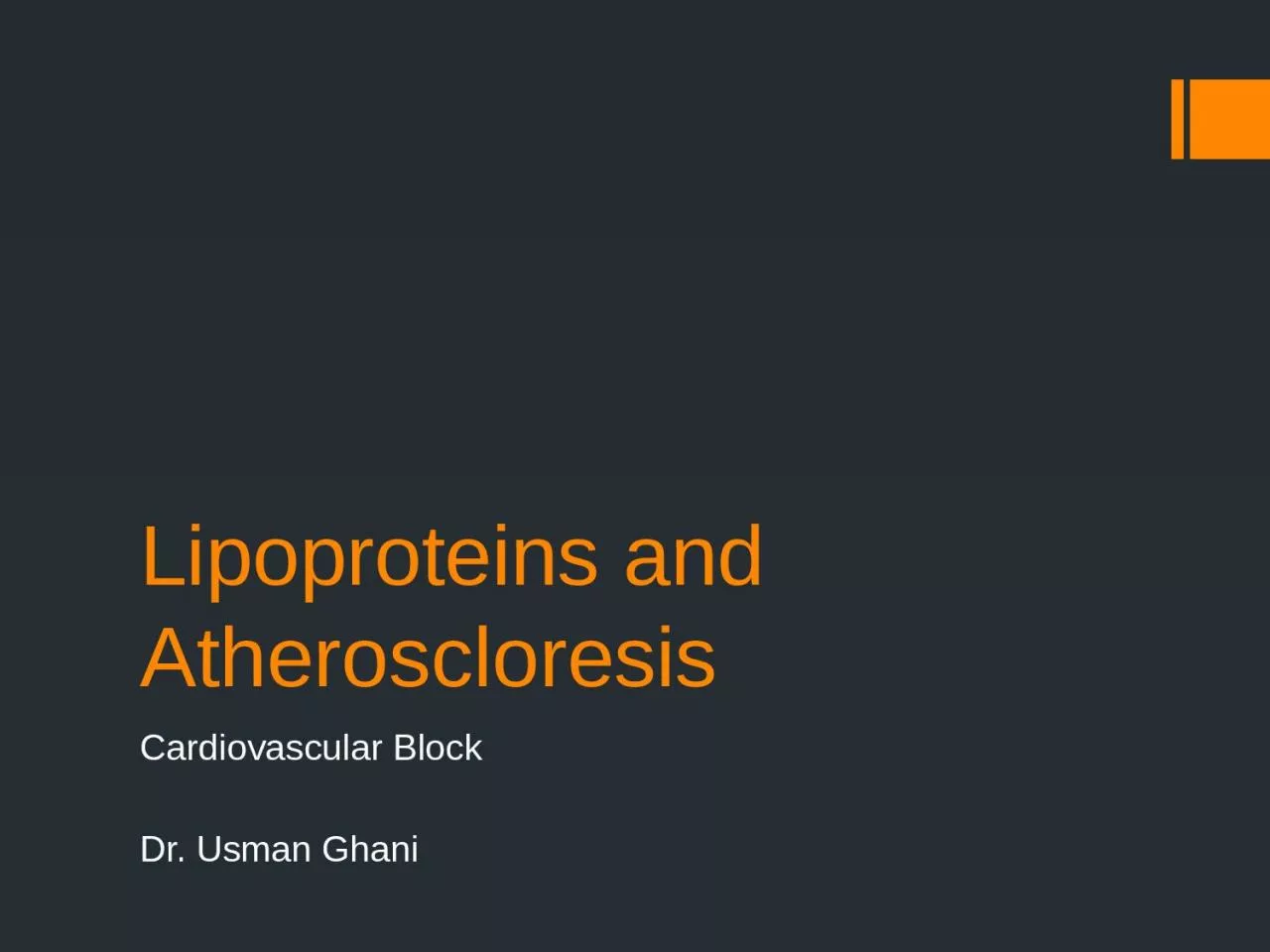

Cardiovascular Block Dr Usman Ghani Objectives By the end of this lecture the First Year students will be able to Correlate the imbalance in lipoprotein metabolism with the development of ID: 1037296
Download Presentation The PPT/PDF document "Lipoproteins and Atheroscloresis" is the property of its rightful owner. Permission is granted to download and print the materials on this web site for personal, non-commercial use only, and to display it on your personal computer provided you do not modify the materials and that you retain all copyright notices contained in the materials. By downloading content from our website, you accept the terms of this agreement.
1. Lipoproteins and AtheroscloresisCardiovascular BlockDr. Usman Ghani
2. ObjectivesBy the end of this lecture, the First Year students will be able to:Correlate the imbalance in lipoprotein metabolism with the development of atherosclerosisUnderstand the functions and metabolism of LDL and HDL cholesterolDescribe the receptor-mediated endocytosis of LDL and its regulationRecognize how LDL is considered a bad cholesterol whereas HDL a good cholesterolUnderstand the biochemistry of atherosclerosis and its laboratory investigationsDiscuss the role of lipoprotein(a) in the development of heart disease
3. OverviewLow density lipoprotein (LDL)Receptor-mediated endocytosis of LDL and its regulationLDL is bad cholesterolHigh density lipoprotein (HDL) and its functionsMetabolism of HDLHDL is good cholesterolAtherosclerosisLipoprotein(a)
4. OverviewCholesterol homeostasis is a balance between cholesterol transport:From the liver to peripheral tissues by LDLFrom peripheral tissues to the liver by HDLImbalance in the above leads to:Cholesterol deposition in blood vesselsThickening and narrowing of the lumen of arteriesAtherosclerosisHeart disease
5. Low density lipoprotein (LDL)LDL particles mainly contain cholesterol and cholesteryl estersProduced from VLDL particlesContain Apo B-100 lipoproteinProvides cholesterol to peripheral tissueLDL binds to cell surface receptors thru Apo B-100Called receptor-mediated endocytosis
6. Receptor-mediatedendocytosis of LDL particlesMajor steps:Binding of Apo B-100 to LDL receptor glycoproteinEndocytosisEndosome formation (LDL vesicle fuses with other vesicles)Separation of LDL from its receptorReceptor is recycledLDL degraded by lysosomes releasing:Free cholesterol, fatty acids, amino acids, phospholipids
7. Cellular uptake and degradationof LDL particles
8. Regulation of LDL endocytosisDown regulation:High intracellular cholesterol level causes:Degradation of LDL receptorsInhibition of receptor synthesis at gene levelReduction in cell surface receptorsDecreased uptake of LDL by cellsDecreased de novo synthesis of cholesterolUp regulation:Low intracellular cholesterol level causes:Recycling of LDL receptorsIncreased receptor synthesis at gene level Increase in cell surface receptorsIncreased uptake of LDL by cellsIncreased de novo synthesis of cholesterol
9. LDL is bad cholesterol Transports cholesterol to peripheral tissuesElevated LDL levels increased risk for atherosclerosis / heart diseaseDeficiency or defects in LDL receptors results in:Decreased uptake of cholesterol by cellsIncreased accumulation of cholesterol in blood vesselsFamilial hypercholesterolemiaPatients are unable to clear LDL from bloodPremature atherosclerosis and heart disease
10. High density lipoprotein (HDL)HDL particles mainly contain:Protein, phospholipids, cholesterol, cholesteryl estersProduced in the liver and intestineContains Apo A-1, C-II and E lipoproteinsTake up cholesterol from peripheral tissues to the liver
11. High density lipoprotein (HDL)Nascent HDL:Disk-shapedContains apo A-I, C-II and E lipoproteinsMainly contains phospholipidsMature HDL:Nascent HDL + cholesteryl esters HDL3HDL3 + more cholesteryl esters spherical HDL2HDL2 transfers cholesterol to the liver
12. Functions of HDLReservoir of apoproteins (Apo C-II and E)Transports cholesterol to liver from:Peripheral tissuesOther lipoproteinsCell membranesSuitable for cholesterol uptake due to:High content of phospholipidsPhospholipids solubilize cholesterol and provide fatty acids for cholesterol esterification
13. HDL metabolism
14. HDL is a good cholesterolHDL transports cholesterol from peripheral tissues to the liver for degradationReduces cholesterol level in tissues and circulation (reverse cholesterol transport)High HDL levels have inverse correlation with atherosclerosisReverse cholesterol transport includes:Cholesterol efflux from peripheral tissues to HDLCholesterol esterification Binding and transfer of cholesteryl ester-rich HDL2 to liverRelease of lipid-depleted HDL3
15. AtherosclerosisLDL uptake by cells is receptor mediatedAdditionally, macrophages possess scavenger receptors called scavenger receptor class A (SR-A)The macrophages take up chemically-modified LDL by endocytosis
16. AtherosclerosisChemically-modified LDL contains oxidized lipids and Apo BUnlike LDL receptors, the SR-A is not down-regulated in response to high intracellular cholesterolCholesteryl esters accumulate in macrophages converting to foam cellsFoam cells contribute to plaque formation and atherosclerosis
17.
18. Lab investigations of atherosclerosisFasting serum lipid profile:TAG level (reflects chylomicron and VLDL levels)LDL, HDL levelsTotal cholesterol level (reflects LDL, HDL and cholesterol levels)Other tests:Serum lipoprotein electrophoresisSerum apoprotein levels (e.g., apo-B)
19. Lipoprotein (a)Lp(a) is identical in structure to LDL particleContains apo(a) in addition to apo B-100High plasma Lp(a) level is associated with increased risk of coronary heart diseaseCirculating levels of Lp(a) are determined by:Genetics (mainly)Diet (trans FAs increase Lp(a) levels)Estrogen (decreases Lp(a) levels)
20. Lipoprotein (a)The apo(a) protein is structurally similar to plasminogenCompetes with plasminogenSlows the breakdown of blood clotsTriggering heart attackA risk factor for CAD
21. Take home messageImbalance in the LDL and HDL metabolism causes increased accumulation of lipids in the bodyLDL is bad cholesterol whereas HDL is good cholesterolThe pathogenesis of atherosclerosis includes the uptake of oxidized LDL by macrophages through scavenger receptor class A (SR-A) producing foam cells and atherosclerotic plaqueIndividuals with high level of plasma Lp (a) are at higher risk for coronary heart disease
22. ReferencesLippincott’s Biochemistry. 6th Edition, Chapter 18, pp. 231-237. Lippincott Williams & Wilkins, New York, USA.